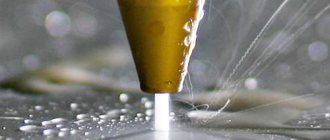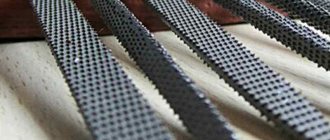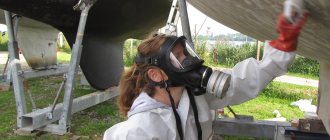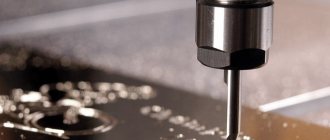Overview characteristics of alabaster
Dry gypsum-based mixtures have different working times. This could be 5 or 45 minutes. Therefore, before diluting alabaster for walls or crafts, you need to familiarize yourself with the features of the building mixture.
Specifications
To produce alabaster, crushed gypsum stone is used, which undergoes heat treatment (+150-180 °C). The distinctive properties from commercial gypsum are based on special additives included in the composition of the fired mass. The result is increased strength, wear resistance and setting time. But due to changes in the chemical composition of the natural material, alabaster is not applicable in medicine, but is in high demand in the construction industry.
How to dilute alabaster depends on the type of mixture based on the speed of hardening. There are three options: fast, normal or slow. The time difference looks like this: 3/15, 7/35, 20/40 minutes for the initial/complete setting of the solution, respectively.
The alabaster solution hardens quickly, so it is better to make small batches
A light translucent composition with various shades (white, gray, yellow, green, pink) is in demand due to the following properties:
- plastic;
- water resistance (higher than gypsum);
- fire resistance (up to +700 °C);
- environmental friendliness;
- high adhesion.
Acoustic properties and ease of use are also noted. If you apply the solution in compliance with the permissible layer, then the dry residue will practically not shrink and will not crack. The coating surface will be smooth and dense.
Application area
Alabaster is most often used in places where efficiency and reliability are required. So, electricians use a solution to fix wires and socket boxes, plumbers fix pipes in grooves and fittings. Painters fill minor chips, cracks and holes with the mixture, and install beacons. It takes a few minutes to work, and the dry residue gains working strength in less than half an hour.
Less commonly, the material is used as an additive to plaster to accelerate its hardening, and as an adhesive for gypsum products (tiles, stone, stucco). Craftsmen use alabaster to create vases, figurines, decorative utensils, and interior elements.
Casting crafts using a plastic mold
Which one to choose - tips for choosing
Most modern building gypsum powder is white. The most applicable gypsum in construction is the one marked G-5, G-6.
This alabaster is widely used for:
- plastering work in dry rooms
- preparation of putty and plaster mixtures according to special recipes
- production of partition panels based on gypsum
- dry plaster in sheet form
- different types of plasterboard sheets
- gypsum fiber and gypsum particle boards
This type of building gypsum is used where high strength characteristics of the material are not required. Due to the presence of a coarse-grained component, it has lower strength and greater porosity.
To meet the needs of industries that require high-strength molds for casting parts for various purposes and performing special work, it is necessary to choose alabaster, which is highly durable, marked from G-13 to G-25. This material complies with modern safety and construction standards.
The cost of quality alabaster
Ordinary building alabaster is considered a relatively inexpensive building material, which makes it extremely popular on the market. It is sold mainly in durable paper multilayer bags designed for 5-50 kg. One kilogram of ordinary building gypsum grade G-5 can cost an average of 5-15 rubles.
Alabaster, characterized by its high strength, is significantly superior to ordinary building gypsum. They are made from gypsum stone, both using traditional technologies and complex chemical and technological processes.
Therefore, such materials are indispensable for:
- sealing of drilled wells in the oil and gas industry
- production of ceramics and sculptures
- production of decorative elements for construction projects
- in medicine for the manufacture of orthopedic and dental prostheses
- molding castings in jewelry making
- high-strength forms for the needs of certain industries
The cost of a kilogram of high-strength gypsum depends on the manufacturer and container volume. It can fluctuate between 9 - 20 or more rubles per kilogram.
Rules for preparing the solution
Alabaster, despite its high adhesion to most substrates, has little contact with rubber. Therefore, to prepare the solution, it is better to use a special bowl or a cut ball or chamber. You can take a plastic container. The metal will have to be constantly cleaned mechanically. As a last resort, use disposable plastic bags for each batch.
To carry out repair work, the following proportions are observed for diluting alabaster (mixture/water):
- 1/0.5 – fixation of wires, boxes, pipes, beacons;
- 1/0.65 – filling minor voids;
- 1/1 – surface leveling.
The mixture must be mixed in a short time (no more than 2 minutes). To prevent the formation of lumps, the powder is added to the water gradually. The volume is selected in accordance with the optimal production during working hours. In case of exceeding 1 liter, it is recommended to use a power tool with a whisk for fine-grained mixtures.
The mixture is added to the kneading water
It is important to remember a common mistake made by beginners. In addition to the exaggerated volume, water is often added to the hardening solution in order to extend working time. As a result of this action, the resulting mixture will be lumpy, crack when drying, and deteriorate in strength characteristics as a whole.
To extend the working time of the solution, carpentry or wallpaper glue can be used. The permissible rate of 2% will not have a noticeable effect on the quality of the mixture. Lime milk is often used instead of water at construction sites.
Alabaster is made from gypsum with the addition of special additives. As a result, the mixture hardens faster, after drying it is stronger and absorbs less moisture.
Light powder is used more often on construction sites in order to quickly and reliably fix materials in recesses and gypsum cladding.
The recipe for preparing the solution is determined by the specific brand of the mixture and its purpose: filling voids, securing products, leveling the base.
Definition and main characteristics
Building gypsum is a natural mineral from the sulfate class.
Its chemical formula is CaSO4·2H2O (calcium sulfate hydrate). Since the molecule of the substance contains 2 water atoms, it is also called calcium diacquasulfate. The fine-crystalline structure with a large number of pores is both a positive quality (provides lightness and resistance to high temperatures) and a negative quality (does not provide strength and moisture resistance).
The optimal porosity of the product after hardening is 40-60%. If it is higher, the product becomes less durable and breaks easily. Porosity depends on the amount of water used when mixing the solution.
The specific gravity of the material is 2.6-2.75 g/cm³. Density in a loose state is 800-1100 g/m³, when compacted it can reach 1450 kg/m³.
What does building gypsum look like externally? It is a fairly finely ground powder, usually white or greyish, sometimes with a yellow or pink tint. The smell is very weak and intensifies when water is added.
The liquid solution (dough) is a gray mass with a specific odor. After drying, it acquires a white or light gray color, the surface of the finished product is smooth to the touch.
Gypsum powder
Gypsum mortar
How to dilute alabaster
Due to its positive qualities, alabaster is widely used in the construction industry. However, when using it, it is important to be careful, because after the dry powder comes into contact with water, it hardens very quickly. It is this property of alabaster that has made it so in demand. Therefore, it is used in cases where it is necessary to carry out work quickly and without loss of quality, for example, when laying wires. In this article we invite you to learn how to dilute alabaster.
How to increase strength and make it stronger
To increase the strength of gypsum surfaces or products, it is recommended to introduce special additives into the solution. These are polymer fiber, various types of glue (CMC, PVA, bone glue), fluff lime, borax, liquid glass. Excellent results are obtained by reinforcing gypsum surfaces with a polymer mounting mesh.
After the gypsum has hardened, it is recommended to treat its surface with a solution of iron or copper sulfate, as well as a solution of Glauber’s salt, to increase its strength properties.
To give a gypsum product strength comparable to the strength of ceramics, it is immersed for a day in a saturated solution of potassium alum. Then the product must be heated to a temperature of 550 degrees. You will be surprised by its durability.
Advantages and disadvantages
Among the positive aspects of alabaster are the following:
- Fast setting. For some jobs this is very important.
- Fire resistance.
- When hardened, it does not shrink.
- Not dangerous for the human body.
- Ability to withstand loads.
Given the fact that alabaster absorbs moisture, it is not recommended for use in rooms with high humidity.
Among the disadvantages is poor resistance to dry and humid air. In the absence of moisture, alabaster loses its technical properties and simply crumbles.
Pros and cons of alabaster
This material has a number of remarkable advantages that make it unique:
- The main one is fast setting, which allows you to quickly start work and ensure high productivity.
- This is a fireproof, non-flammable material that prevents the spread of fire.
- Excellent binding indicators.
- Possibility of quickly reaching the strength declared by the manufacturer.
- Made from natural raw materials, it is harmless to humans.
- Low density provides excellent sound insulation properties and ease of machining.
- Moisture-regulating abilities, which are expressed in the absorption of excess moisture and its release when the air in the room is excessively dry.
This time-tested, versatile and unique building material has good prospects for use in construction, industry and other areas.
It optimally combines aesthetics, affordable price, functionality and quality. Taking this into account, there is no real alternative to alabaster, either today or in the foreseeable future.
Alabaster
- This is gypsum powder. It has been known for many thousands of years and, depending on its composition, has been used for construction and decorative purposes. In general, it has an environmentally friendly composition, however, it is not widely used in medicine. Only in construction, making handicrafts, decorative jewelry, figurines.
Compared to its relative, gypsum, alabaster hardens faster. The assortment includes gypsum mixtures that have distinctive hardening times and water consumption for diluting the solution. But in general, this is approximately 5 minutes from the start of setting of the solution and from 10 to 30 minutes until final hardening.
Article navigation:
Maintaining proportions is an important factor
As for the proportions, they are prescribed by building codes and regulations. For example, according to SNIP they are expressed as follows: 650 ml of water or lime mortar should be consumed per 1 kg of dry mixture. To fasten the wire during electrical installation work, 500 ml of water is required per 1 kg. If it is necessary to obtain a liquid mixture of alabaster, then the proportion is 1:1.
Drying time
Hardening of gypsum occurs with the release of heat, that is, it is an exothermic reaction. This contributes to the fact that during drying it slightly (up to 1%) increases in volume. This distinguishes it from other binders, including cement, which shrink when hardened.
The first stage of hardening is setting. The semi-liquid mass thickens, losing its plasticity, and becomes more dense. At the second stage, the solution becomes solid, but retains a loose structure. At the third, final stage, the looseness disappears along with the evaporating water and the material finally hardens, becoming durable.
Construction gypsum
How long the construction gypsum dries before it completely hardens depends on the brand, the amount of water taken for mixing and the presence of additives. It generally gains strength within 20-30 minutes after application or casting, and final drying occurs after 2 hours.
Selecting utensils for kneading
Unlike other solutions, such as putty, alabaster dries very quickly. For this reason, it is necessary to take a serious approach to the choice of utensils for kneading alabaster dough. Using a metal bowl or bucket is not recommended. In this case, it will be difficult for you to remove residues from their surface. Therefore, it is best to dilute the solution in a rubber or plastic container. Dried alabaster is removed by squeezing the container.
If you need to knead in a small portion and once, then place a plastic bag in any convenient container. Fix the film securely around the edges. Upon completion, the film is removed.
Alternatively, you can knead it in an old rubber ball. To do this, cut it and make a knead in the inside. You can also cut a plastic bottle (1.5 or 2 liters) lengthwise.
About the intricacies of growing alabaster
The main feature of water mixtures with alabaster is their rapid hardening. This circumstance should be taken into account before starting to breed it. In addition, the speed of setting leads to the formation of hardened mixture residues in the containers underneath. Therefore, sometimes it is not easy to remove them from metal buckets and tanks.
To save yourself from mistakes when breeding alabaster you need to:
- prepare the mixture in small portions to prevent it from hardening earlier than after five minutes
- for dilution, it is better to use containers made of rubber or silicone, which are easy to clean
- place a plastic bag inside the container, the top edge of which is securely fixed before stirring
- strictly observe the ratio of alabaster and water to prepare a specific solution
- pour dry alabaster into water gradually, stirring constantly until a mass is obtained without lumps and bubbles
At what proportions is building plaster obtained?
Construction plaster can be prepared for various finishing operations. For each of them, regulatory documentation provides for certain requirements for the preparation of asbestos solution. So, if it is intended to be used to fill grooves when performing work related to laying electrical wiring, one kilogram of alabaster should be diluted in half a liter of water.
When preparing a plaster mortar based on alabaster and lime, a kilogram of dry powder is diluted in 650 grams of lime mortar or water. A liquid putty solution, with the help of which unevenness on the walls is leveled, a kilogram of dry building plaster is poured into a liter of water.
Recommendations for growing alabaster
The main thing when diluting alabaster is to pour the dry mixture into water. If this is done in small portions while stirring, the formation of lumps is minimized.
However, a high-quality solution is also ensured:
- using mechanical tools in the form of a drill with stirring attachments
- moistening the alabaster while stirring by hand, after which it is intensively stirred with a spatula
- inadmissibility of diluting a mixture that has set with liquid due to loss of quality
Preparation of alabaster dough
Construction alabaster is prepared in different proportions, in relation to water, based on the purpose of its use. So, if it is necessary to level walls or partitions, then the mixture is mixed 1:1. To install distribution boxes, a viscous mass is required - 2:1.
If during the work the alabaster begins to harden, then do not try to add water to it. It should be thrown away immediately.
The kneading process itself boils down to adding the dry mixture to water, but not vice versa. The process of adding powder should be gradual. Otherwise, there is a risk that the entire mass will form a lump that cannot be broken. Alternatively, you can use a drill with a mixer attachment for stirring. In this case, you will be able to make a batch without a single lump.
The consistency of alabaster should resemble thick sour cream. For all components of the mixture to react, it is enough to wait half a minute. After this, you can cover the cracks or perform other actions. All work must be carried out quickly and at the same time carefully.
Alabaster
After finishing work, it is important to thoroughly rinse all the tools; it is recommended to wash them in warm water.
When mixing, use only cold water at room temperature. Hot water speeds up the setting process several times.
So, we looked at the features of alabaster for walls, as well as the technique of mixing it. By following all the recommendations given, we hope that you will be able to mix alabaster correctly.
Concept, types, properties
It is called building alabaster or gypsum, consisting of a dry mixture of components. Gypsum is considered the main substance among them. The elasticity of alabaster and its adhesion are ensured by polymer components. This material is classified as non-flammable, environmentally friendly natural materials. It has excellent soundproofing properties and water resistance.
Advantages and disadvantages
Before you start working with a mixture prepared from alabaster powder, you should study the characteristics of the material used. The powder is inexpensive and is in deserved demand among buyers for its excellent technological performance. In general, building alabaster has the following properties:
This finishing material is light in weight and does not shrink during the hardening process. If the question arises as to whether alabaster is harmful to human health, then we can absolutely say that it is safe. The powder is predominantly white in color, but it also occurs in other colors: light gray, yellow, and sometimes it has greenish and pink shades.
What temperature can alabaster withstand? It can withstand exposure to significant temperatures. Resists heat up to 700° without destruction. The destructive consequences of interaction with open fire will be visible after 6 hours.
Negative characteristics of the material include its insufficient strength and inability to withstand heavy loads. Due to the fact that alabaster can absorb water when hardening, it should not be used in particularly damp rooms. The frozen alabaster mixture does not like it when the air around is dry and hot, then the material will simply crumble due to loss of moisture reserves and a decrease in viscosity. Such disadvantages are eliminated by introducing various additives into the alabaster solution.
Features of the material
When working, you must remember the features inherent in this substance. In addition to the rapid hardening characteristic of it, it is capable of increasing in volume. A distinctive feature of this material is also that it does not stick to the surface of rubber products. It is even recommended to prepare a solution from it in a regular rubber ball. The material is stored in a dry place with humidity not exceeding 60%.
Types of alabaster
Currently, according to the speed of hardening, the material is divided into the following types:
In the first case, the mixture used will begin to set a few minutes after its preparation, and after a quarter of an hour it will completely harden. The solution of the second type will begin to harden after preparation after 7 minutes, and will finally harden in 35 minutes. For the latter type of mixture, hardening begins after 20 minutes. from the moment of preparation, and the solution will finally harden after 40 minutes.
How to properly dilute alabaster or plaster for children's crafts and topiary
Gypsum and alabaster were known to the ancient Egyptians, who lived long before our era. Decorative stone was popular among ancient craftsmen. The ancient material has not lost its relevance today. Gypsum and its varieties are affordable and easy to work with. It is used in medicine, interior decoration, as well as for making rosettes, bas-reliefs, souvenirs and crafts. Depending on the purposes, different breeding technologies are used.
We will discuss how to properly dilute alabaster for finishing, how much powder to add to the liquid, what are the nuances of preparing a gypsum mixture for homemade art, and what ways can you improve the quality and strength of products made from gypsum and alabaster.
Recommendations for working with the solution
Construction trowel
The first step in the work is spraying. For application, use a construction steel trowel without defects. Spraying is performed by sharply throwing the solution onto the wall away from you. You need to correctly calculate the force so that the solution does not bounce off the wall and hit the floor.
The primer and coating are applied with a wide spatula. It is better to install beacons so that you can work according to them as a rule. When the covering has dried a little, take plastic construction float
How to properly dilute plaster for different purposes?
Depending on the purpose, gypsum dough can have different consistencies. To make castings, especially precision ones, a liquid solution is required that can completely replicate the internal relief of the mold. For repair and finishing work, a paste-like mass is more suitable - it is easier to put it on a spatula and use it to cover voids, gaps or leveling wall panels. The main difference in each type of batch is the ratio of gypsum powder and water.
For making magnets, bas-reliefs
Gypsum is an environmentally friendly material, safe for humans. Thanks to this quality, it is widely used for creating crafts and children's creativity. You can cast a beautiful bas-relief from plaster or make funny figures for coloring. If you insert a magnet into such a figurine during the casting process and then paint it, you will get a nice magnet for the refrigerator.
Manufacturing technology for decorative castings:
- pour water into a mixing container (it is better to take dishes with a rounded bottom rather than a flat one);
- prepare plaster for creativity (the volume should be approximately twice the amount of liquid available, more precise proportions are indicated in the instructions for this material);
- gradually adding powder, stir with a whisk until the consistency of liquid sour cream or pancake batter is obtained (water cannot be added during the kneading process);
- pour the mixture into the prepared mold (instead of special molds, you can use silicone molds for ice or baking);
- insert a magnet or other fastener (depending on the purpose of the product);
- leave to harden.
The hardened castings are removed from the mold and left to dry. Drying the gypsum stone takes from several days to several weeks, depending on the size of the craft. After complete drying, the bas-relief or figures can be painted with acrylic paints or felt-tip pens.
For topiary
Topiary refers to artificial trees in a pot made in different ways. Instead of soil, plaster is poured into the pot, in which the trunk or branches are fixed. How to dilute plaster for the base of topiary? There are two methods for mixing gypsum mortar for topiary:
How to dilute for plastering walls
Lime mortar for plaster with the addition of alabaster must be prepared very quickly and in small quantities so that it does not have time to harden
First you need to decide on the type of solution, which is selected depending on the type of finishing work. So, if the outer walls of a building are being leveled, it is advisable to use a cement-based solution; indoors it is advisable to use a lime mixture. But a solution with the addition of alabaster (lime-gypsum) is ideal for eliminating all kinds of errors.
Mixing mortar for plaster begins with creating a dry mixture, which is then diluted with water with the addition of alabaster substance. As a container, you can use any container with a flat bottom and walls at least 10 cm high (box, trough, bowl or bucket). The procedure is as follows:
- Pour sand evenly into the container.
- Add lime paste in a ratio of 1:5.
- Mix the mixture thoroughly with a shovel or a construction mixer until smooth.
- Gradually add water while stirring the solution. The finished mixture should have the consistency of rich sour cream.
- We prepare alabaster dough with the expectation that its ratio to the finished lime mortar should be 1:4.
- Add the gypsum substance to the container with the original mixture and mix well, but not for very long.
Helpful advice: Based on the fact that the lime-gypsum mortar begins to harden after about five minutes, mix the amount of construction mixture that you can use during this time. At the same time, it is advisable to spend no more than two minutes on preparing the portions themselves.
Video instructions for preparing plaster mortar
Alabaster: what is it, why is it needed and how to work with it?
Alabaster as a building material is today used in a wide range of diverse fields of construction and art. It is often used in production processes, in the construction industry and in everyday life.
Due to its mineral origin and environmental friendliness, it is constantly in great demand.
The process of producing alabaster consists of burning gypsum raw materials followed by fine grinding. The resulting material is characterized by high softness, which is comparable only to talc. Thanks to this, construction gypsum is very convenient to use. It is very pliable, easily susceptible to all kinds of mechanical influences: finishing with a chisel, saws and files. To speed up the setting and hardening process, alabaster is added to the limestone solution. Its hardening time is about six minutes, and its strength also increases.
Many people are mistaken when they call gypsum alabaster. Visually distinguishing them is extremely difficult even for an experienced builder. But all the differences lie in their properties.
- Gypsum has a wide range of uses. Unlike alabaster, it is used not only in the construction industry, but also in medicine (dental clinics, trauma departments);
- Alabaster is a material that dries very quickly. This property is the main source of problems when working with this product, because you have to work very quickly. To combat this, many builders use special impurities that are added to the solution to reduce the rate of hardening. Depending on the drying time, it has about twelve varieties.
The grade of alabaster means its characteristics regarding the compressive load and its hardening time. The designation is made by combination. For example, marking G30 means that a layer that has completely hardened will withstand a pressure of about 30 kilograms per square centimeter. The finished mixture is sold in bags of various weights. Diluted with water.
How to apply it correctly?
One of the main rules is to start diluting the mixture using a small amount. The setting time is short, so you can simply miscalculate and ruin part of the product. It is necessary to dilute only with cold water until the mixture becomes viscous. It is worth remembering: “Add alabaster to water, and not vice versa.” Stirring is done thoroughly and as quickly as possible; the use of special equipment (drill with attachment) is encouraged. The presence of lumps in the finished mixture is extremely undesirable. After the mixture is added to a container of water, you need to immediately start mixing; there is no need to wait until the powder gets wet.










